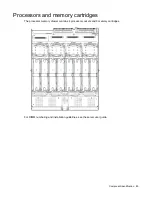
Diagnostic tools 75
•
The Boot Mode remains in UEFI Boot Mode even if the default boot mode is Legacy Boot Mode.
•
The Secure Boot Database is not restored to its default state.
•
iSCSI Software Initiator configuration settings are not restored to defaults.
Embedded UEFI shell
The system BIOS in all ProLiant Gen9 servers includes an Embedded UEFI Shell in the ROM. The UEFI
Shell environment provides an API, a command line prompt, and a set of CLIs that allow scripting, file
manipulation, and system information. These features enhance the capabilities of the UEFI System
Utilities.
For more information, see the following documents:
•
HPE UEFI Shell User Guide for HPE ProLiant Gen9 Servers
on the Hewlett Packard Enterprise
http://www.hpe.com/info/uefi/docs
http://www.uefi.org/specifications
Embedded Diagnostics option
The system BIOS in all ProLiant Gen9 servers includes an Embedded Diagnostics option in the ROM.
The Embedded Diagnostics option can run comprehensive diagnostics of the server hardware, including
processors, memory, drives, and other server components.
For more information on the Embedded Diagnostics option, see the
HPE UEFI System Utilities User
Guide for HPE ProLiant Gen9 Servers
on the Hewlett Packard Enterprise website
http://www.hpe.com/info/uefi/docs
iLO RESTful API support for UEFI
The ProLiant Gen9 servers include support for a UEFI compliant System BIOS, along with UEFI System
Utilities and Embedded UEFI Shell pre-boot environments. ProLiant Gen9 servers also support
configuring the UEFI BIOS settings using the ILO RESTful API, a management interface that server
management tools can use to perform configuration, inventory, and monitoring of a ProLiant server. The
ILO RESTful API uses basic HTTPS operations (GET, PUT, POST, DELETE, and PATCH) to submit or
return JSON-formatted data with iLO web server.
For more information about the ILO RESTful API and the RESTful Interface Tool, see the Hewlett Packard
http://www.hpe.com/info/restfulinterface/docs
Re-entering the server serial number and product ID
After you replace the system board, you must re-enter the server serial number and the product ID.
1.
During the server startup sequence, press the
F9
key to access UEFI System Utilities.
2.
Select the
System Configuration
>
BIOS/Platform Configuration (RBSU)
>
Advanced Options
>
Advanced System ROM Options
>
Serial Number
, and then press the
Enter
key.
3.
Enter the serial number and press the
Enter
key. The following message appears:
The serial number should only be modified by qualified service personnel.
This value should always match the serial number located on the chassis.
4.
Press the
Enter
key to clear the warning.
5.
Enter the serial number and press the
Enter
key.
6.
Select
Product ID
. The following warning appears:
Summary of Contents for ProLiant DL580 Gen9
Page 5: ...Contents 5 Documentation feedback 106 Index 107 ...
Page 13: ...Customer self repair 13 ...
Page 14: ...Customer self repair 14 ...
Page 15: ...Customer self repair 15 ...
Page 98: ...Cabling 98 Front video USB cabling Power supply data cabling ...
Page 99: ...Cabling 99 Standby power cabling Systems Insight Display cabling ...






























